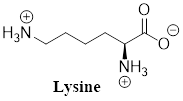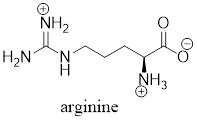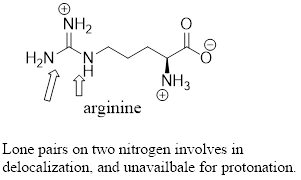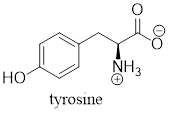
Concept explainers
Draw the predominant form of the following amino acids at physiological pH (7.4):
- a. Lysine
- b. Arginine
- c. tyrosine
(a)
Interpretation:
The predominant form of lysine at physiological
Concept introduction:
Acid-base properties of Amino acids:
Every amino acid has a carbonyl group and an amino group, and each group can exist in an acidic form or a basic form, depending on
The compound exists primarily in the acidic form in solutions that are more acidic than their
At
Answer to Problem 29P
The predominant form of lysine at physiological

Explanation of Solution
The predominant form of glutamine at physiological

(b)
Interpretation:
The predominant form of arginine at physiological
Concept introduction:
Acid-base properties of Amino acids:
Every amino acid has a carbonyl group and an amino group, and each group can exist in an acidic form or a basic form, depending on
The compound exists primarily in the acidic form in solutions that are more acidic than their
At
Answer to Problem 29P
The predominant form of lysine at physiological

Explanation of Solution
The predominant form of lysine at physiological

(c)
Interpretation:
The predominant form of tyrosine at physiological
Concept introduction:
Acid-base properties of Amino acids:
Every amino acid has a carbonyl group and an amino group, and each group can exist in an acidic form or a basic form, depending on
The compound exists primarily in the acidic form in solutions that are more acidic than their
At
Answer to Problem 29P
The predominant form of tyrosine at physiological

Explanation of Solution
The predominant form of tyrosine at physiological

Want to see more full solutions like this?
Chapter 17 Solutions
Pearson eText for Essential Organic Chemistry -- Instant Access (Pearson+)
- Describe the principle of resonance and give a set of Lewis Structures to illustrate your explanation.arrow_forwardDon't used hand raitingarrow_forwardIt is not unexpected that the methoxyl substituent on a cyclohexane ring prefers to adopt the equatorial conformation. OMe H A G₂ = +0.6 kcal/mol OMe What is unexpected is that the closely related 2-methoxytetrahydropyran prefers the axial conformation: H H OMe OMe A Gp=-0.6 kcal/mol Methoxy: CH3O group Please be specific and clearly write the reason why this is observed. This effect that provides stabilization of the axial OCH 3 group in this molecule is called the anomeric effect. [Recall in the way of example, the staggered conformer of ethane is more stable than eclipsed owing to bonding MO interacting with anti-bonding MO...]arrow_forward
- 206 Pb 82 Express your answers as integers. Enter your answers separated by a comma. ▸ View Available Hint(s) VAΣ ΜΕ ΑΣΦ Np, N₁ = 82,126 Submit Previous Answers ? protons, neutronsarrow_forwardPlease draw the inverted chair forms of the products for the two equilibrium reactions shown below. Circle the equilibrium reaction that would have a AG = 0, i.e., the relative energy of the reactant (to the left of the equilibrium arrows) equals the relative energy of the product? [No requirement to show or do calculations.] CH3 CH3 HH CH3 1 -CH3arrow_forward5. Please consider the Newman projection of tartaric acid drawn below as an eclipsed conformer (1). Please draw the most stable conformer and two intermediate energy conformers noting that staggered conformers are lower in energy than eclipsed forms even if the staggered conformers have gauche relationships between groups. [Draw the substituents H and OH on the front carbons and H, OH and CO₂H on the back carbons based on staggered forms. -CO₂H is larger than -OH.] OH COH ICOOH COOH COOH 1 2 COOH COOH 3 4 Staggered Staggered Staggered (most stable) Indicate the number of each conformer above (1, 2, 3 and 4) that corresponds to the relative energies below. Ref=0 Rotation 6. (60 points) a. Are compounds 1 and 2 below enantiomers, diastereomers or identical? OH OH HO HO LOH HO HO OH 2 OH OH b. Please complete the zig-zag conformation of the compound (3R,4S)-3,4-dichloro-2,5-dimethylhexane by writing the respective atoms in the boxes. 3.arrow_forward
- The plutonium isotope with 144 neutrons Enter the chemical symbol of the isotope.arrow_forwardThe mass ratio of sodium to fluorine in sodium fluoride is 1.21:1. A sample of sodium fluoride produced 26.1 gg of sodium upon decomposition. How much fluorine was formed?arrow_forward32S 16 Enter your answers numerically separated by a comma. Np. Nn = 跖 ΟΙ ΑΣΦ Submit Request Answer ? protons, neutronsarrow_forward
- Chemistry: Matter and ChangeChemistryISBN:9780078746376Author:Dinah Zike, Laurel Dingrando, Nicholas Hainen, Cheryl WistromPublisher:Glencoe/McGraw-Hill School Pub Co
